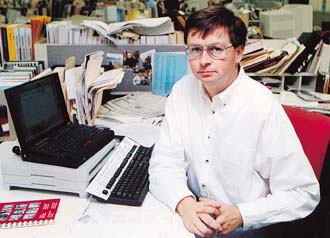 |
 |
| current issue |  |
past issues |  |
send a letter/news |  |
address update |  |
advertise |  |
about us |  |
alumni home |
Features
Making Sense of the Media CircusAmid fabrication, sensationalism and saturation coverage, a Pulitzer prize-winning reporter talks to prominent alumni journalists about the waning credibility of the profession they love.
by Barbara Walsh '81
 Illustration by Phil Foster
Illustration by Phil Foster
|
W ORD OF THE BETRAYAL SPREAD QUICKLY.
Boston Globe reporters gasped when they heard the news. Patricia Smith, a Globe columnist revered for her elegant prose and powerful stories about poverty, racism and hate, had been forced to resign. A Pulitzer Prize finalist, Smith got caught breaking the cardinal rule in journalism. She lied to her readers. She made up quotes and people in many of her columns.
The news stunned Smith's colleagues, particularly Rebecca Mahoney '99, a University of New Hampshire journalism student interning at the Globe.
"It was like someone had died," Mahoney says. "The reporters all talked about it like someone had been in a car accident or something. To see one of your own betray one of the most basic rules in journalism was tough."
Before the summer and her Globe internship were over, Mahoney got another lesson in journalism ethics. In August, a month after Smith quit, the Globe asked for the resignation of Mike Barnicle, a popular columnist who championed the working class, accusing him of writing fiction instead of fact. "After Barnicle, there was a horrible sense of humiliation," Mahoney says. "We're supposed to seek truth and report it. How are we supposed to explain this to anyone?"
 "When you're in this business you know how sausage is made, and when you read quotes that sound too good to be true, it makes you skeptical." —Dennis Cauchon '81, reporter, USA Today.
"When you're in this business you know how sausage is made, and when you read quotes that sound too good to be true, it makes you skeptical." —Dennis Cauchon '81, reporter, USA Today.
|
The media's credibility slipped even further as its other misdeeds made headlines throughout the summer. Cable News Network and its corporate partner, Time magazine, retracted a story that had accused the U.S. military of killing American Vietnam War deserters with nerve gas, admitting the expose was based on flimsy sources. The New Republic, a Washington-based political magazine, confessed that one of its star reporters, Stephen Glass, had made up 27 of his 41 stories and created fictional documents and Web sites to buttress his lies. The Cincinnati Enquirer agreed to pay $10 million to Chiquita Brands International after learning that an overzealous reporter had broken into Chiquita's voice-mail system and eavesdropped on thousands of private phone messages. And the media fed on the story of President Bill Clinton's affair like frenzied fish, racing to report the titillating details long after the public had registered its disgust with the whole sordid mess.
One veteran Florida columnist, writing about the media's unethical behavior, noted: "When the news becomes the news, the news is in trouble."
Journalists hadn't suffered such a blow to their credibility since 1981, when Washington Post reporter Janet Cooke won and later lost a Pulitzer Prize for her phony story about a nine-year-old heroin addict named Jimmy.
In newsrooms big and small, editors and reporters were asking themselves: Was the summer of 1998 just a fluke, or was unethical behavior and sloppy, sensationalist reporting epidemic? Would newspaper readers and television viewers harbor even more cynicism and revulsion toward the press? Would the media scandals drive students away from journalism careers?
The Golden Age was Yellow

|
Historically, the relationship between the public and the press has always been tenuous. Since the early days of newspapers, journalists have twisted the truth and tested their readers' loyalty. Hoaxes about monsters, natural disasters and petrified men routinely made headlines in the 1800s.
Toward the 1900s, newspaper magnates William Randolph Hearst and Joseph Pulitzer gave birth to yellow journalism, unabashedly plying their biases and political views on the front page. Scandalous, sensational headlines screamed from the banners of Hearst's New York Morning Journal and Pulitzer's New York World. The two publishers even promoted the Spanish-American War with outrageous stories designed to sell more newspapers.
Today, a century later, the public trusts the press about as much as they trust used car salesmen. And recent polls suggest that journalists may be losing ground. A survey completed last October found that 88 percent of the 1,016 adults questioned believed reporters often or sometimes use unethical or illegal tactics to get a story. Two-thirds thought journalists make up stories, and another 85 percent felt that stories in the media often contain factual errors. Fifty-four percent of those surveyed said the media is too sensational and biased and hinders the country from resolving its problems.
Page: 1 2 3 4 Next>Easy to print version
blog comments powered by Disqus

